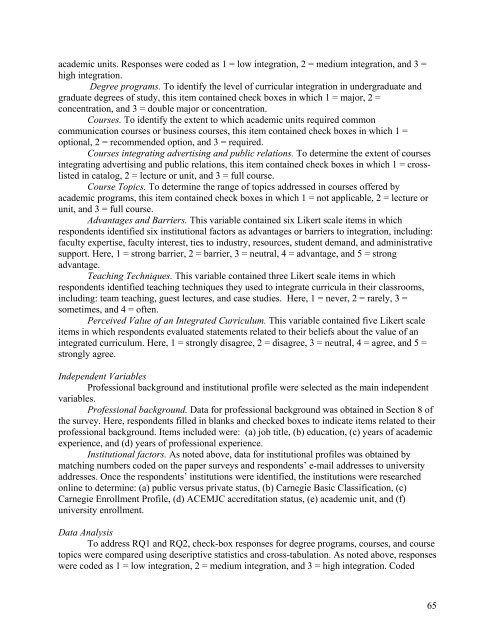2008 PROCEEDINGS - Public Relations Society of America
2008 PROCEEDINGS - Public Relations Society of America
2008 PROCEEDINGS - Public Relations Society of America
Create successful ePaper yourself
Turn your PDF publications into a flip-book with our unique Google optimized e-Paper software.
academic units. Responses were coded as 1 = low integration, 2 = medium integration, and 3 =<br />
high integration.<br />
Degree programs. To identify the level <strong>of</strong> curricular integration in undergraduate and<br />
graduate degrees <strong>of</strong> study, this item contained check boxes in which 1 = major, 2 =<br />
concentration, and 3 = double major or concentration.<br />
Courses. To identify the extent to which academic units required common<br />
communication courses or business courses, this item contained check boxes in which 1 =<br />
optional, 2 = recommended option, and 3 = required.<br />
Courses integrating advertising and public relations. To determine the extent <strong>of</strong> courses<br />
integrating advertising and public relations, this item contained check boxes in which 1 = crosslisted<br />
in catalog, 2 = lecture or unit, and 3 = full course.<br />
Course Topics. To determine the range <strong>of</strong> topics addressed in courses <strong>of</strong>fered by<br />
academic programs, this item contained check boxes in which 1 = not applicable, 2 = lecture or<br />
unit, and 3 = full course.<br />
Advantages and Barriers. This variable contained six Likert scale items in which<br />
respondents identified six institutional factors as advantages or barriers to integration, including:<br />
faculty expertise, faculty interest, ties to industry, resources, student demand, and administrative<br />
support. Here, 1 = strong barrier, 2 = barrier, 3 = neutral, 4 = advantage, and 5 = strong<br />
advantage.<br />
Teaching Techniques. This variable contained three Likert scale items in which<br />
respondents identified teaching techniques they used to integrate curricula in their classrooms,<br />
including: team teaching, guest lectures, and case studies. Here, 1 = never, 2 = rarely, 3 =<br />
sometimes, and 4 = <strong>of</strong>ten.<br />
Perceived Value <strong>of</strong> an Integrated Curriculum. This variable contained five Likert scale<br />
items in which respondents evaluated statements related to their beliefs about the value <strong>of</strong> an<br />
integrated curriculum. Here, 1 = strongly disagree, 2 = disagree, 3 = neutral, 4 = agree, and 5 =<br />
strongly agree.<br />
Independent Variables<br />
Pr<strong>of</strong>essional background and institutional pr<strong>of</strong>ile were selected as the main independent<br />
variables.<br />
Pr<strong>of</strong>essional background. Data for pr<strong>of</strong>essional background was obtained in Section 8 <strong>of</strong><br />
the survey. Here, respondents filled in blanks and checked boxes to indicate items related to their<br />
pr<strong>of</strong>essional background. Items included were: (a) job title, (b) education, (c) years <strong>of</strong> academic<br />
experience, and (d) years <strong>of</strong> pr<strong>of</strong>essional experience.<br />
Institutional factors. As noted above, data for institutional pr<strong>of</strong>iles was obtained by<br />
matching numbers coded on the paper surveys and respondents’ e-mail addresses to university<br />
addresses. Once the respondents’ institutions were identified, the institutions were researched<br />
online to determine: (a) public versus private status, (b) Carnegie Basic Classification, (c)<br />
Carnegie Enrollment Pr<strong>of</strong>ile, (d) ACEMJC accreditation status, (e) academic unit, and (f)<br />
university enrollment.<br />
Data Analysis<br />
To address RQ1 and RQ2, check-box responses for degree programs, courses, and course<br />
topics were compared using descriptive statistics and cross-tabulation. As noted above, responses<br />
were coded as 1 = low integration, 2 = medium integration, and 3 = high integration. Coded<br />
65
















